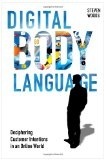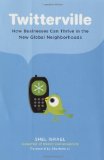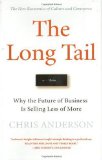#EE10SF – Joe Payne, CEO of Eloqua – Keynote Summary

I’m currently attending the Eloqua Experience Conference in San Francisco and will provide quick summaries of the keynotes/presentations that I attend.
Joe Payne, CEO of Eloqua, gave a keynote presentation this morning titled Unleashing Your Revenue Engine. Simply, the keynote highlighted the concept of Revenue Performance Management or RPM.
RPM in a Nutshell
The idea is to provide sales and marketing with a consistent way to measure and report efforts back to the C-Suite. For example, looking at days leads outstanding (DLO), which analyzes the number of days of marketing quality leads (MQL) to closed sales.
Eloqua is proposing a single framework – called the C-Suite 16 (“Suite 16” for basketball fans), which provides reports across all industries. With this framework, C-level, sales and marketing can pinpoint key questions to identify opportunities and grow the company versus focusing on “marketing is giving us bad leads” or “sales isn’t working the leads.”
Conclusion
Too often, we hear about the friction between sales and marketing. With a consistent language and methodology, this gap can finally be closed, allowing sales & marketing to drive corporate growth forward, cooperatively. Kudos to Eloqua if it succeeds in developing this common language.
PRMM Interview – Ken Molay of Webinar Success

Webinars has become an important toll for marketers. I asked Ken Molay, president and founder of Webinar Success, to share his thoughts on the evolution of webinars, how marketers can best leverage this for their programs, and what to expect in a couple of years. Here is Ken’s bio:
Ken Molay is president and founder of Webinar Success, a consulting firm that assists companies in producing and delivering effective and compelling web seminars. Ken combines a technical background with experience in corporate marketing and public presentations. He is a prolific blogger on the subject of web conferencing and its applications, and has been quoted in the Wall Street Journal and industry publications. He is a frequent public speaker on the topic of more effective webinars.
You’ve been writing about webinars for awhile. What is the most significant change that you’ve seen?
I started using webinars as a marketing tool some ten years ago. At that time, the concept was a novelty. I was constantly explaining what they were. Now webinars are ubiquitous and almost every business person has at least attended one, if not presented one. Attendance rates for marketing webinars used to be very high, averaging 50-60% of registrants. Now they average 33%. People will no longer attend just for the experience of trying out a new learning medium. As usage becomes more common, presenters spend less time and effort on preparation. This is rapidly leading to audience dissatisfaction as they attend more and more online sessions where presenters read text off slides, sound disinterested in their own material, and don’t seem to care about delivering value as much as collecting names and emails on the registration form. Companies who host webinars need to “up their game” and concentrate on creating value for their attendees in both content and presentation.
So webinars have become a key tool in a marketer’s toolkit. What are the top three things that marketers need to consider when using webinars for their programs?
a) The webinar title, promotional efforts, and content MUST be framed in terms of audience interests and benefits instead of the host’s informational content. Instead of telling your audience “We wanted to tell you about our latest offering” you need to tell them “Learning about our latest offering will benefit you in the following ways.”
b) Watch out for the “successful webinar” trap. Many marketing departments try a webinar and get good results on gathering leads and seeing a very positive cost-benefit. So the boss says, “Great! Do one of these a week. This is a cheap lead generating machine!” You end up with “list exhaustion” as people don’t want to attend that frequently and you end up with “presenter exhaustion” as there is not enough time to prepare and rehearse compelling content. Your presenters view it as an inconvenient distraction from their “real jobs”. Quality goes down, your audience stops coming, and your boss gets angry.
c) Your success in turning marketing webinar attendees into sales prospects is greatly influenced by your speed of response after the event. Don’t just dump the registration list into a CRM system for eventual follow up by a salesperson. A “follow up” call or email two weeks later has the same psychological impact as a cold call. You need to send follow up email within 24 hours of your webinar. Immediately following the event, have someone go through the webinar chat log or feedback responses, looking for people who asked a specific product question or requested a contact. Get back to them the same day. Have your supporting material or collateral ready to send… Don’t wait until after the webinar to assemble it.
The space has become more crowded with more vendors and offerings. Where do you see the industry going in 1-2 years?
Video is the hot item of the year. Vendors are rapidly adding what they refer to as “high def” streaming video capabilities to their webinar products. I am comfortable with presenter video in smaller team meeting applications, but I am not a fan of live video for public marketing webinars. It puts a tremendous additional burden on the presenter, who cannot easily move around, look at notes, or check the web conferencing console without breaking eye contact with the audience. It is harder to create a professional corporate image with video because of the many subtle visual cues we respond to as viewers without consciously realizing it. Video also demands much more bandwidth, and companies run the risk of excluding or delivering subpar experiences for attendees with slower network connections. So I think we may see a wider adoption of video conferencing initially, followed by a pullback (at least for marketing webinars) while companies wait for infrastructure to catch up and for their production teams to learn a new set of best practices.
The other trend I see developing is a desire for easier monetization of webinars. This does not directly affect marketing webinars, but many companies want to deliver fee-based training, consultation, and support to a wider audience than they can reach with in-room seminars. There are not enough technology choices and integrated features in the market to make this easy and cost-effective to implement.
Have you leveraged webinars for your program? If so, share your successes, lessons learned and more below.
Rise of Social Commerce – Nielsen and Hallmark Summaries
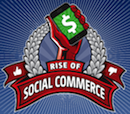 I attended the second day of the Altimeter Group’s Rise of Social Commerce conference last week. This is the second post summarizing the sessions at the conference. The first highlighted Charlene Li’s Open Leadership presentation.
I attended the second day of the Altimeter Group’s Rise of Social Commerce conference last week. This is the second post summarizing the sessions at the conference. The first highlighted Charlene Li’s Open Leadership presentation.
Nielsen – Social Media Does Correlate to Sales
Pete Blackshaw of Nielsen provided some stats and insight into the role of mobile and social media on commerce. The key message is that social media does correlate to sales. Whether it’s the trigger for the sale or the function of the echo chamber, Pete’s message is that it still correlates to sales.
Of the stats that he presented, these caught my eye:
* mobile phones will overtake PCs by 2015
* main ways to discover is through search and Word of Mouth
Implications for Marketing and PR
These stats demonstrates the importance of evaluating the ways we reach and connect with audience through our marketing and public relations efforts. Understanding the trends that trigger word of mouth are more important than ever to determine what will drive business forward. As Pete stated, “Many social conversations begin offline.”
Being able to tap both online and offline conversations, while helping your clients be found in the way that audiences want to find you, will become a more integral part of our jobs.
Hallmark – Blazing the Trail
Camille Lauer of Hallmark provided a different perspective – how a traditional card company is moving into the social arena. the company’s goal is to have people consider Hallmark beyond major holidays to every day moment. The challenge, according to Camille, Hallmark, is being sensitive to their physical, retail business and franchises.
Creating an Authentic Voice
Camille was very forthright on what worked and didn’t work as they cautiously moved into the social arena. Their goal was creating a more authentic voice that resonated with their audience. As part of this effort, they launched card contests, inviting their audience to submit unique cards. One winner would then be selected to have his/her card produced for the Shoebox line.
While the card contests were a hit, they quickly realized that their community wanted to hear from Hallmark. The Hallmark team began filming behind-the-scenes videos to share the card selection and judging process with their audience. This allowed their audience to connect more with the company and engage in an ongoing conversation.
Keeping It Simple – Facebook App
Yes, the physical card company does have a Facebook App – the Hallmark Social Calendar. For Hallmark, the goal is to translate emotions into bite-sized goods and virtual gifts. At first, the company added a lot of bells and whistles and realized that people only wanted a simple calendar.
The company also learned to encourage engagement with the audience (earn points through activity with the application) and how people wanted to pay for the virtual gifts.
Conclusion
Pete’s presentation provided great insight into how consumers are discovering and purchasing goods, while Camille highlighted how a 100 year-old company is moving into the digital arena. In the end, no matter what you do or create, you have to keep the customer center throughout. It’s amazing how often we forget that as marketers and PR professionals.
Are you currently implementing a mobile marketing strategy or have used the Hallmark Social Calendar? If so, share your experiences below.
Push versus Pull for PR and Marketing

Last week, I read two very good blogs posts from Tim Dyson (The end of Push PR/Marketing) and Beth Harte (Dear Marketing & PR Pros: You’re still pushing) regarding the broadcast tendency of public relations and marketing professionals.
In Tim’s post, he explores how social media is providing brands an opportunity to shape existing online conversations. As he writes, “shifting the debate is a way of shaping a conversation” and I agree with him.
The rapidly changing technology landscape has changed the way we consume and receive content. No longer can a brand buy air time on the big three TV networks and own the messaging. The ability to engage customers directly is an opportunity for brands to become part of the conversation. But this requires transparency and dedication to listen to what customers have to say versus reverting to our natural tendency to defend.
Or as Beth writes, “… marketing and PR practitioners still approach customers socially as if we are going into battle with them.” She raises the good point that PR and marketing professionals are still unfamiliar with the concept of “people relations.”
Conclusion
I would like to conclude with the comment that I left on Beth’s post:
“Whether PR practitioners or marketers, this is an interesting dynamic. The focus, for the most part, is on accumulating followers, fans and/or readers as a way to drive one’s own marketing messages. I’ve rarely seen true engagement on the level that Zappos does with its customers.
Which leads to another point to explore. We’re discussing who owns social media as part of the marketing or PR function. While marketing or PR can initiate the program, I believe that full participation of the entire organization is required to truly have a successful program.
For example, if your goal is to improve your net promoter scores, you have to get customer service involved. Otherwise, there will be a disconnect for consumers who are receiving one message from marketing and PR lead social media campaigns but experiencing something different with customer service.
So I would add to your point Beth – “Know why you are doing so and only do it when it makes the most sense. Stop with the shotgun approach.” And make sure that the right stakeholders are also on board and participating.”
What are your thoughts on this topic? Do you agree or disagree?
Photo Credit: via Flickr by Robert S. Donovan
Does Size Matter with Virtual Events?
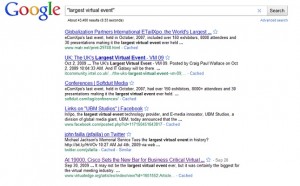 Many virtual events vendors and companies have touted that they have held the “largest” virtual event. Cisco GSX in 2009 with 19,000 attendees and AMD with 672,000 attendees in 2006 (Forrester Report, Market Overview: Virtual Event Platforms for B2B Marketers) are just a couple of examples. A quick search on the term “largest virtual event” yields over 40,000 results on Google – some referring to vendors with others referencing events.
Many virtual events vendors and companies have touted that they have held the “largest” virtual event. Cisco GSX in 2009 with 19,000 attendees and AMD with 672,000 attendees in 2006 (Forrester Report, Market Overview: Virtual Event Platforms for B2B Marketers) are just a couple of examples. A quick search on the term “largest virtual event” yields over 40,000 results on Google – some referring to vendors with others referencing events.
But does size really matter?
While an important indicator of a platform’s scalability, I think the focus on size overlooks other key factors when determing the value of virtual for your marketing and communications campaigns.
Metrics
The largest event may not necessarily yield the right results for your company. Many of the platform providers have detailed metrics regarding the number of attendees, length of stay, number of downloads and more. The challenge is how developed is their analytics engine to provide a layer of intelligence to interpret that data.
Questions to consider: What type of metrics are provided? What format are these metrics provided to me – excel data sheets or graphs? Are there lead scoring capabilities to identify A, B and C leads? If so, how does it work? Does the vendor help me to calculate ROI? A discussion on Focus, a resource for business professionals, provides more discussion about the ROI of virtual events.
User Engagement
Developing an experience that is unique to your company, ties back to your brand, and is engaging requires thoughtful planning. With hundreds and thousands of potential attendees, how do you structure the environment to intuitively create a flow within your virtual event. A critical element is mapping out how you want people to engage with one another, exhibitors and speakers within the event.
Questions to consider: Can I use a cookie cutter template or do I need something more custom? Will the vendor work with me or do I have to provide this? Do I have to use an agency in addition to the platform provider? How much time do I need to accomplish the desired experience? How do I create the right attendee flow within my virtual event?
Learning
The main component of any event is the content. Driving people to the virtual event is one aspect, while delivering content in a way that imparts learning is another element.
Questions to consider: Beyond how long somebody attends my event, what ways are there to measure short-term and long-term retention? Can you test or quiz the audience before, during and after an event? Will this cost more? What delivery method works best (video, audio, text, combo) and why?
Conclusion
While you host or build the largest event, a truly successful virtual event goes beyond size. It provides the right metrics with an engaging experience that delivers real learning to you audience.
What other factors are there to consider?
WITI Summit: Summary of Social Media, Cloud, and Mobility Sessions
 I attended the WITI Summit earlier this week, recapping the keynotes on the first day. On the second day, I attended three panel sessions on the Applied Cloud, New Opportunities in the Mobile Market, and Social Media Business Solutions. Below is my summary of these sessions:
I attended the WITI Summit earlier this week, recapping the keynotes on the first day. On the second day, I attended three panel sessions on the Applied Cloud, New Opportunities in the Mobile Market, and Social Media Business Solutions. Below is my summary of these sessions:
Applied Cloud Panel Discussion
The panel discussion highlighted the benefits of cloud applications in terms of cost efficiencies, speed to implementation, scalability, and flexibility. Vanessa Alvarez, analyst with Frost & Sullivan, indicated that a hybrid approach (on-premise and cloud) may emerge which may ease issues with integration across multiple vendors and data.
While the benefits of cloud applications was discussed, the issue of data integration was present. According to R. Ray Wong, analyst with the Altimeter Group: ” Integration is very hard. Going backwards to best of breed … People are going out to procure apps themselves. Integration has to come back to have same reports. Everything is coming back as have to have a good data architecture and how the business processes get tied back for reporting. Then can talk about data integration.”
In the end, the possibility of SaaS suites will emerge.
Mobile Marketing
Mobile is becoming an integral part of our lives. The panel clarified that there are six types of mobile applications: 1. Communications, 2. Games, 3. Multimedia, 4. Productivity (email, calendaring, etc.), 5. Travel, and 6. Utilities (address book, task manager, etc.).
Considering that the US has double the number of smartphones than China, which is second worldwide, there is ample opportunity for marketers to leverage mobile. The key takeaway was to provide your audience with useful applications that address their needs. For example, applications for new mothers would be an interesting opportunity for Johnson & Johnson or other company targeting new moms.
Social Media Business Solutions
The panel consisted of representatives from Meebo, Paypal, and IBM. For me, I found how Paypal and IBM leveraged social business very interesting:
Paypal Leverages Social for Community Forum and Customer Service
Paypal is leveraging social media as part of the service’s web self-service. The goal is to provide a long-term community to better understand the needs of their audience. For Paypal, the value is understanding the cost of product development and launch. With web analytics, they are also able to track customers and determine the path for communications help.
IBM Connects with Partners with Virtual Event
For IBM, they built a robust virtual event to learn from partners and provide them the information they need from IBM. 5,000 partners attended the virtual event live with 2,500 accessing the archive. IBM’s goal was not to replace its physical event with virtual. Rather, they can be selective with face-to-face events, using virtual to supplement the face-to-face.
In terms of value, they reviewed the analytics to measure against their objectives, such as engagement, did the conversations continue beyond the event, or was the conversation at a deeper level.
WITI Summit – Summary of Keynotes
 The WITI Summit was held this past week in San Jose. Founded to help women advance in technology, the first day of the summit had some powerful keynotes. I was able to catch presentations by Sally Jenkins, Vice President, Worldwide Marketing, Symantec; Sandy Carter, VP, Software Business Software, IBM; and (my favorite!), Dr. Ruth Westheimer.
The WITI Summit was held this past week in San Jose. Founded to help women advance in technology, the first day of the summit had some powerful keynotes. I was able to catch presentations by Sally Jenkins, Vice President, Worldwide Marketing, Symantec; Sandy Carter, VP, Software Business Software, IBM; and (my favorite!), Dr. Ruth Westheimer.
 I have summarized the presentations by Sally and Sandy below. And while I would like to summarize Dr. Ruth’s presentation, much of her content was very specific and not appropriate for the blog, if you know what I mean =) It was a great honor to hear her speak, as well as to meet her personally. I will post summaries of some key sessions tomorrow.
I have summarized the presentations by Sally and Sandy below. And while I would like to summarize Dr. Ruth’s presentation, much of her content was very specific and not appropriate for the blog, if you know what I mean =) It was a great honor to hear her speak, as well as to meet her personally. I will post summaries of some key sessions tomorrow.
Brand Transformation – Sally Jenkins
Sally described the process that Symantec have been undergoing over the past 3 years to rebrand and reposition Norton. She highlighted key questions to consider:
1. What does the data say?
2. What is the buzz in the market about your brand and competitors?
3. Are you listening to your customers?
4. Can you wait any longer to change?
5. Are you listening to your gut?
For Norton, they looked at what story they had to tell to create buzz within the category. They decided to have a purpose which highlighted what they stood for and would lend itself to a dialogue. The story was about fighting cybercrime. The methodology included:
– research
– edutainment for engagement and to communicate the stats
– the media strategy was focused online
– and developed a physical exhibit that discussed the “black market” of identify theft to educate the masses
They implemented this through their channels and with one voice internationally. Internally, they wanted their employees to live and breathe the brand of fighting cybercrime:
– held seminars
– created brand story book for every employee
– gave employees new mission – fight cybercrime, not sell software.
– rethink role for each job- main competitor is cybercriminal
The results?
– Customers now stay with Norton for an average of 4 yrs
– 47 percent share of voice
– Winning on all channels
– Turned Norton haters into advocates
– Multiple product awards
Social Media Ecosystem – Sandy Carter
Sandy discussed how the ecosystem around your company is very powerful. Previously, it was about one-way marketing and now it’s more open. In fact, she quoted one study which stated that 80 percent of CEOs will go outside of the company for recommendations about services and the brand.
With this in mind, Sandy highlighted the ANGELS framework:
– Analyze
– Nail the story and strategy
– Go to market
– Energize communications
– Leads and revenue
– Scream – breakthrough the noise
For example, IBM leveraged a game to energize partners and students before placing it online. This online game is now the number 1 lead generation tactic, moving the game from edutainment to lead generation.
About
Favorite Service
Recent Comments
- on Going Virtual Isn’t Necessarily the Answer to Replacing Your Physical Events
- on Going Virtual Isn’t Necessarily the Answer to Replacing Your Physical Events
- on Going Virtual Isn’t Necessarily the Answer to Replacing Your Physical Events
- on Going Virtual Isn’t Necessarily the Answer to Replacing Your Physical Events
- on Going Virtual Isn’t Necessarily the Answer to Replacing Your Physical Events
Ads by Google
Favorite Books
Marketing Blogs
PR Blogs
- KD Paine's Measurement Blog
- Micro Persuasion
Virtual Events & Meetings Blogs
- Cisco Virtual Environments
- It's All Virtual
- The Webinar Blog
- Virtual Edge Institute

 Follow
Follow Cece Salomon-Lee is director of product marketing for Lanyon Solutions, Inc. and author of PR Meets Marketing, which explores the intersection of public relations, marketing, and social media.
Cece Salomon-Lee is director of product marketing for Lanyon Solutions, Inc. and author of PR Meets Marketing, which explores the intersection of public relations, marketing, and social media. 